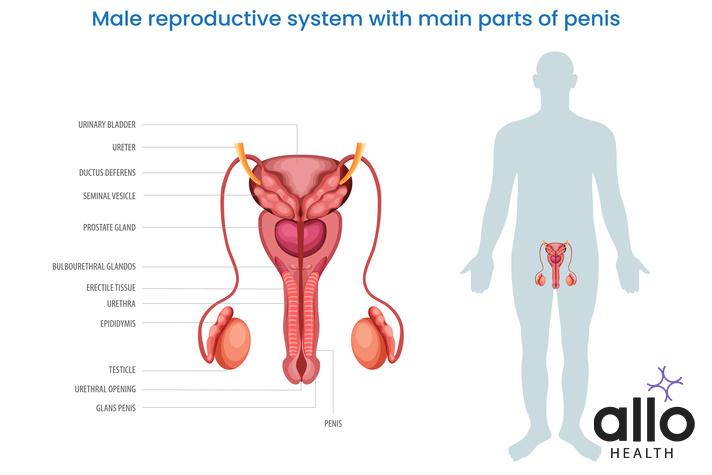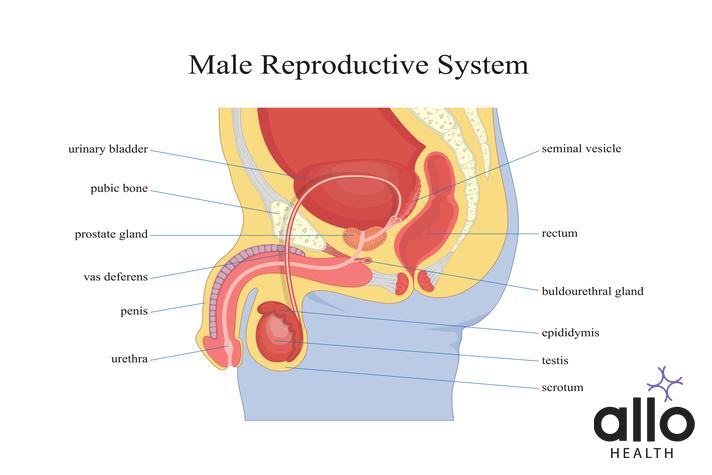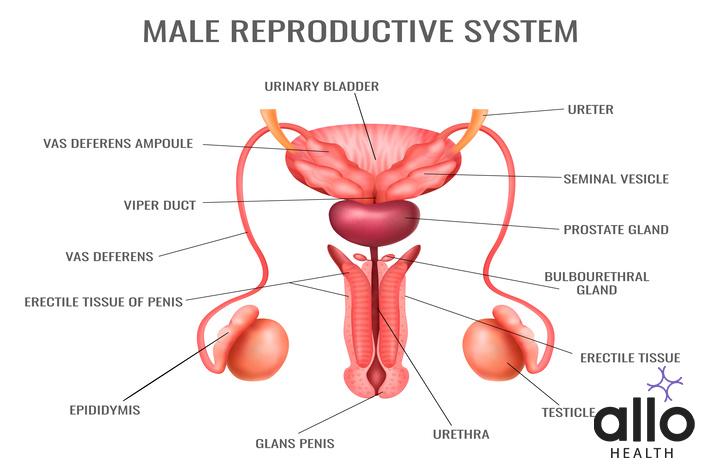How to Increase the Size of a Male Reproductive Organ?

Allo Health is dedicated to personalized well-being, offering support and trusted information tailored to individual health goals. The platform emphasizes human-generated content, led by a distinguished medical team of experts, including physicians and sexual health specialists. Their commitment to credibility involves rigorous fact-checking, authoritative research, and continuous updates to ensure accurate, up-to-date information. Allo Health's unique approach goes beyond conventional platforms, providing expert-led insights and a continuous commitment to excellence, with user feedback playing a crucial role in shaping the platform's authoritative voice.

Dr.Sushma.V completed MBBS degree from BGS GIMS,bangalore
Why This Was Upated?
Our experts continually monitor the health and wellness space, and we update our articles when new information became available.
Updated on 10 April, 2024
- Article was updated as part of our commitment to diversity, equity, and inclusion.

"The following blog article provides general information and insights on various topics. However, it is important to note that the information presented is not intended as professional advice in any specific field or area. The content of this blog is for general educational and informational purposes only.
Book consultation
The content should not be interpreted as endorsement, recommendation, or guarantee of any product, service, or information mentioned. Readers are solely responsible for the decisions and actions they take based on the information provided in this blog. It is essential to exercise individual judgment, critical thinking, and personal responsibility when applying or implementing any information or suggestions discussed in the blog."
In a world where physical appearance holds significant sway, discussions surrounding male reproductive organ size are often met with curiosity and interest. Despite the plethora of information available, navigating through the sea of purported solutions can be daunting. This article aims to provide a comprehensive guide on enhancing the size of the male reproductive organ naturally.
By delving into scientifically-backed methods and debunking myths, we offer readers a reliable resource to address their concerns. From lifestyle adjustments to holistic approaches, we explore techniques that prioritize safety and efficacy, empowering individuals on their journey toward self-confidence and well-being.
What is the Male Reproductive System and How Does It Work?
The components comprising the male reproductive system fulfill the following functions:
- Generating, sustaining, and conveying sperm cells and semen. Sperm cells represent the male reproductive organs, while semen acts as a safeguarding fluid encompassing sperm.
- Expelling sperm.
- Generating and secreting male sex hormones.
Function of the Male Reproductive System
- Follicle-Stimulating Hormone (FSH): Produced by the pituitary gland, FSH is pivotal for spermatogenesis, the process of sperm production.
- Luteinizing Hormone (LH): Also synthesized by the pituitary gland, LH supports the continuity of spermatogenesis, ensuring the progression of sperm production.
- Testosterone: As the primary sex hormone in individuals assigned male at birth (AMAB), testosterone governs various characteristics such as muscle mass, strength, fat distribution, bone density, and libido, crucial for the proper functioning of the male reproductive system.
External Parts of the Male Reproductive System

- External Genitalia: Consists of the penis, scrotum, and testicles. Also referred to as genitals or genitalia they also have reproductive cells.
- Penis: Organ for sexual intercourse. Comprises the root, body (shaft), and glans (head). Erectile tissue fills with blood during arousal, facilitating erection. The urethra expels urine and semen during ejaculation. Studies suggest that the average penis is about 3.5 inches (8.9 cm) when flaccid (soft) and a little more than 5 inches (13 cm) when erect.
- Scrotum: A loose sac of skin behind the penis. Holds testicles and regulates temperature for sperm production. Contracts to keep testicles warm and relax to cool them.
- Testicles: Oval-shaped organs in the scrotum, producing sperm and testosterone. Seminiferous tubules inside produce sperm through spermatogenesis. Sperm mature and are stored in the epididymis before moving to the vas deferens.
- Epididymis: The epididymis, situated on the back of each testicle, stores and matures sperm. Muscle contractions during sexual arousal propel sperm into the vas deferens for ejaculation.
Internal Parts of the Male Reproductive System
- Vas Deferens: The vas deferens is a lengthy, muscular tube extending from the epididymis into the pelvic cavity, positioned just posterior to the urinary bladder. It serves to convey mature sperm to the urethra in anticipation of ejaculation.
- Ejaculatory Ducts: Arising from each testicle’s vas deferens, these ducts merge with seminal vesicle ducts to form ejaculatory ducts. Passing through the prostate, they gather fluid to augment semen, ultimately emptying into the urethra.
- Urethra: Functioning as a conduit for urine expulsion from the bladder, the urethra also facilitates semen ejaculation during orgasm in individuals with a penis.
- Seminal Vesicles: These sac-like structures attach to the vas deferens near the bladder’s base, contributing up to 80% of ejaculatory fluid, semen containing fructose that serves as a sperm energy source and enhances motility.
- Prostate Gland: Situated beneath the bladder and anterior to the rectum, the walnut-sized prostate secretes additional fluid into ejaculate, providing nourishment for sperm, with the urethra traversing its center.
- Bulbourethral (Cowper) Glands: Pea-sized glands flanking the urethra below the prostate, produce a clear, lubricating fluid that neutralizes residual urinary acidity, aiding in urethral lubrication.
Ways to Increase Testicle Size

There is no scientifically substantiated method to augment testicle size. Testicular size has minimal to negligible influence on their functionality. Nevertheless, individuals can prioritize the well-being of their testes to maintain good health. Strategies to achieve this include:
- Maintaining a cool and comfortable temperature around the testes, as indicated by research.
- Increasing the consumption of vitamin D and other fat-soluble vitamins in the diet has been linked to heightened testosterone levels and improved sperm production, according to studies.
- Opting for comfortable underwear and allowing the cremasteric reflex to naturally occur in the body and manage stress levels. The serotonin cells help in the production of sperm.
Make Your Testis Strong
- Physical Activity for Gonadal Health: Engaging in regular exercises can promote better scrotal health by facilitating proper airflow. However, it’s important to note that exercise does not directly affect testicular size.
- Caution with Testicle Weights: Testicle weights, often used as sex toys, should be approached with caution. While some may tout them as a method for increasing testes size, research suggests they can cause damage if used excessively.
- Testicle Massage: Testicle massage, involving gentle rubbing and massaging, may promote scrotal activity and alleviate discomfort. However, contrary to popular belief, it doesn’t lead to significant changes in testicular size. It’s primarily beneficial for promoting comfort and relieving pain.
Factors That Affect Penis Size and How to Work on it?
- Genetics: Penis size matter, the male sex organ is largely determined by genetics, with variations influenced by family traits.
- Hormonal Factors: Testosterone levels during puberty play a significant role in penile growth, and sperm count with hormonal imbalances potentially affecting the normal size.
- Lifestyle and Health: Factors such as obesity, smoking, and poor cardiovascular health can impact blood flow to the penis, affecting its size and function. Adopting a healthy lifestyle, including regular exercise and a balanced diet, can support overall sexual health.
In summary, genetics, hormonal factors, and lifestyle choices all contribute to penis size, with maintaining good health being key to optimal function.
Natural Methods to Increase the Size of a Male Reproductive Organ
- Regular exercise: Incorporate pelvic floor exercises like Kegels exercise to enhance blood flow.
- Healthy diet: Consume foods rich in antioxidants, vitamins, and minerals to support reproductive health.
- Adequate hydration: Drink plenty of water to maintain tissue health and hydration levels.
- Stress management: Practice relaxation techniques to reduce cortisol levels, which can affect reproductive function.
- Proper sleep: Ensure sufficient rest to regulate hormone production and promote overall well-being.
- Herbal supplements: Explore natural remedies like ginseng fruit and horny goat weed for potential benefits.
- Consultation: Seek advice from healthcare professionals for personalized guidance and recommendations if you have any medical conditions as well.
Surgical Options for Enlarging a Male Reproductive Organ
- Penile Lengthening Surgery: A procedure to increase the length of the penis by releasing the ligaments that attach it to the body.
- Penile Girth Enhancement: Techniques like fat transfer or dermal fillers increase the circumference of the penis and even there are hormone replacement therapy.
- Penile Implants: Inflatable or semi-rigid implants inserted into the penis to achieve erections.
- Platelet-Rich Plasma (PRP) Therapy: Injection of PRP into the penis to stimulate tissue growth.
- Vacuum Erection Devices: Non-surgical option using a vacuum pump to draw blood into the penis and create an erection.
- Penile Exercises: Techniques like jelqing or stretching exercises to potentially increase size over time.
Side Effects Associated with Penis Enlargement Techniques
- Injury: Techniques like stretching or pumps can lead to tissue damage or penile fractures.
- Infection: Open wounds or unsterile equipment may introduce bacteria, causing infections.
- Erectile Dysfunction: Excessive manipulation can disrupt blood flow, leading to temporary or permanent ED.
- Scarring: Aggressive methods may result in unsightly scars or deformities.
- Psychological Effects: Unrealistic expectations or dissatisfaction can lead to anxiety or depression.
- Wasted Resources: Costly procedures or products may yield minimal or no results.
- Lack of Regulation: Many enlargement methods lack proper oversight, increasing the risk of harm.
Conclusion
In conclusion, while the desire to enhance male reproductive organ size is common, it’s crucial to approach the topic with caution and realism. Rather than focusing solely on size, prioritizing overall reproductive health through lifestyle changes, proper nutrition, and regular exercise is paramount. Embracing one’s body with acceptance and understanding that size does not equate to masculinity or sexual prowess fosters a healthier mindset. Seeking guidance from medical professionals for safe and evidence-based methods, if pursued, is advisable. Ultimately, self-confidence and satisfaction stem from a holistic view of oneself, beyond physical attributes, fostering a fulfilling and contented life.
Most Asked Questions
-
What methods are available to increase the size of the male reproductive organ?
There are various methods, including exercises, supplements, surgeries, and devices, but effectiveness and safety can vary.
-
Are there any natural exercises that can help in increasing size?
Yes, exercises like jelqing and stretching are often promoted, but results may be minimal and risks include injury and discomfort.
-
Do supplements or pills work for enhancing size?
While some supplements claim to increase size, scientific evidence supporting their effectiveness is lacking, and they may pose health risks.
-
What about surgical options?
Surgical procedures like penile implants or ligament release surgery exist, but they carry significant risks and potential complications.
-
Are there any non-invasive methods with proven results?
Non-invasive methods like vacuum pumps may temporarily increase size by drawing blood into the organ, but long-term effects and safety are uncertain. It's important to consult with a qualified healthcare professional before attempting any method to increase organ size.






































